CIMR-LDRS: Das Leuchtturmprojekt für Non-Dependence der europäischen Raumfahrt geht planmäßig in die Herstellungsphase des Qualifikationsmodells (EQM)
CIMR-LDRS: Das Leuchtturmprojekt für Non-Dependence der europäischen Raumfahrt geht planmäßig in die Herstellungsphase des Qualifikationsmodells (EQM)
Schon lange bevor 2022 ein unsägliches Blutbad das Ende friedvollen Lebens im Osten Europas besiegelte, hatte in der deutschen und europäischen Raumfahrt die Forderung nach technologischer „Non-Dependence“ eine Spitzenposition unter den strategischen Prioritäten erobert. Besonders im Fokus: große im Raum entfaltbare Reflektorantennen, geeignet für Missionen aller Art.
Die Geschichte dieser deutschen Technologie für Europa begann vor mehr als einem Jahrzehnt mit SCALABE, einer seitens ESA finanzierten Technologieentwicklung und SMERALDA (SME´s Radar and Large Deployable Antenna), einer von der deutschen Raumfahrtagentur finanzierten Studie mit maßgeblicher Beteiligung des Antennenspezialisten HPS GmbH. Über weitere technische Kapitel erfolgreicher Konkretisierung des Ziels mit maßgeblicher Unterstützung von ESA und EU führten die die Münchner schließlich 2020 ein Konsortium von meist mittelständischen Partnern aus acht Ländern zum spektakulären Gewinn des 115-Millionen-Euro Auftrags seitens des Prime`sThalesAlenia Space (TAS) für „CIMR LDRS“ (Large Deployable Reflector Subsystem): die größte rotierende entfaltbare Reflektorantennen-Konstruktion der Welt für das Copernicus-Leuchtturmprojekt CIMR (Copernicus Imaging Microwave Radiometer) der EU zur Beobachtung von Land, Eis und Ozeanen insbesondere der Arktis aus dem All unter dem Management der europäischen Raumfahrtagentur ESA. Das LDR-Subsystem besteht aus Reflektor, Arm, Entfaltelektronik, Verkabelung, verschieden Niederhaltemechanismen und Thermal-Hardware.
Nach langer Designphase und intensiver Iteration mit dem direkten Kunden TAS in Rom und dem Endkunden ESA erfolgte der Startschuss im Rahmen der Phase C/D durch den Abschluss des ersten so genannten „Manufacturing Readiness Review“ für Bau und Test eines Qualifizierungsmodells (Engineering Qualification Model, EQM). In diesen Tagen des Frühjahrs 2025 läutete nun HPS die intensive Phase der Herstellung des EQM endgültig ein.
Herausforderungen auf dem Weg zu neuen Ufern
Die technischen Herausforderungen waren und sind immens, denn Ziel ist kein geringeres als ein entfaltbares Reflektor-Konstrukt für hohe Frequenzen (Ka-Band) mit acht Metern Durchmesser an einem ebenfalls entfaltbaren acht Meter langen Arm, das sich im Orbit achtmal pro Minute um die eigene Achse dreht. Das resultiert in extremen Anforderungen wie etwa der eines RMS-Wertes (Root Mean Square) für die Oberflächengenauigkeit, der um einiges kleiner sein soll als 1/10 mm auf die gesamten 50 m² Reflektorfläche, oder einer erlaubten Abweichung der 8m entfernten Armspitze von maximal lediglich 10mm vom Nominalwert, Schwingungen, Zentrifugalkraft und Thermalverformungen inbegriffen.
Nicht weniger anspruchsvoll waren und sind die Herausforderungen an das Management der vielfältigen Aspekte des Projektes. Eine herausragende Rolle nimmt dabei von Anfang an die Programmleitung des CIMR-Teams der ESA und seitens TAS ein, während die für ihre Heritage im institutionellen, militärischen und kommerziellen Antennenbau bekannte HPS GmbH – neben der eigenen Entwicklungsarbeit auf Arm-und Subsystemlevel – die Führung des Konsortiums aus rund einem Dutzend KMU obliegt, darunter so herausragende Innovationstreiber wie die Münchner LSS GmbH für das entfaltbare Reflektorassembly (DRA), basierend auf einer höchst erfolgreichen, langjährigen Entwicklungspartnerschaft. Von der ehemaligen portgiesischen HPS-Tochter und heutigen FHP stammen die Leichtbau-Karbonstrebenfür das DRA, die INVENT GmbH steuert die kohlefaserverstärkten Rohre für den auf 8-Meter entfaltbaren Haltearm (DAA) bei, NanoSpace Schweiz entwickelt und produziert die hochgenauen und gleichzeitig stabilen, motorgetriebenen Gelenke des Arms, HPS-Rumänien und INEGI Portugal die Konstruktionen für Bodentests und Transporte („MGSE“). Darüber hinaus ist HPS verantwortlich für die Bereitstellung des Zentralelementes für den entfaltbaren Reflektor: das messbar beste Ka-band MESH von HPtex, das es in 9m x 9m Größe überhaupt zu kaufen gibt – und nebenbei als „made in Germany“ europäische Non-Dependence von der Vision in die Realität überführt. Denn ein MESH in solch Dimensionen gab es bis dahin nur aus amerikanischer Produktion. Ursprünglich als wesentliches Element der deutsch-europäischen Lieferkette für CIMR geplant, verkauft das 2020 gegründete Joint-Venture HPTex GmbH (JV aus Iprotex GmbH & Co. KG und HPS GmbH) mittlerweile seine Meshprodukte weltweit, insbesondere auch in asiatischen wie kontinentalamerikanischen Ländern. Das EQM-Mesh für CIMR ist kürzlich aus der HPtex-Fertigung gekommen.
Ende des Jahres stehen die wichtigsten Komponenten (DAA und DRA) bereit, die Serie der Tests beginnt früh in 2026.
„Wer vorne sein will, sollte keine Angst vor dem Unbekannten haben“ (Ernst K. Pfeiffer)
Wenn 2029 CIMR an Bord einer Vega C zu seiner Mission auf sonnensynchroner Bahn aufbricht, um jeweils von früh bis spät u.a. Eisschilde und Schnee unter Beobachtung zu nehmen, winkt Europa nicht nur der Gewinn der Erkenntnisse aus dem Projekt, sondern auch die Gewissheit, den Schritt zur technologischen LDRS-Unabhängigkeit gemeistert zu haben. LDRS sind eben auch Produkte für eine Reihe von militärischen Anwendungen, die gerade in diesen Jahren zu einer gesteigerten Verteidigungsfähigkeit beitragen können. HPS-CEO Ernst K. Pfeiffer sieht darin noch einen über den unmittelbaren Projekterfolg weit hinausreichenden Meilenstein: „Dieses Raumfahrtprojekt ist klarer Beleg dafür, dass die Mentalität aller Projekt-Beteiligten – der Industrie wie der Institutionen – eine ganz andere ist als die der Risikoscheu, welche die Öffentlichkeit vor allem Deutschland, teils auch der ESA normalerweise unterstellt. Keine Angst vor dem Unbekannten zu haben ist der erste Schlüssel zum Erfolg. Vorne ist nun mal da, wo es dunkel wird. Besonders im Weltraum. Aber eben nicht nur da.“
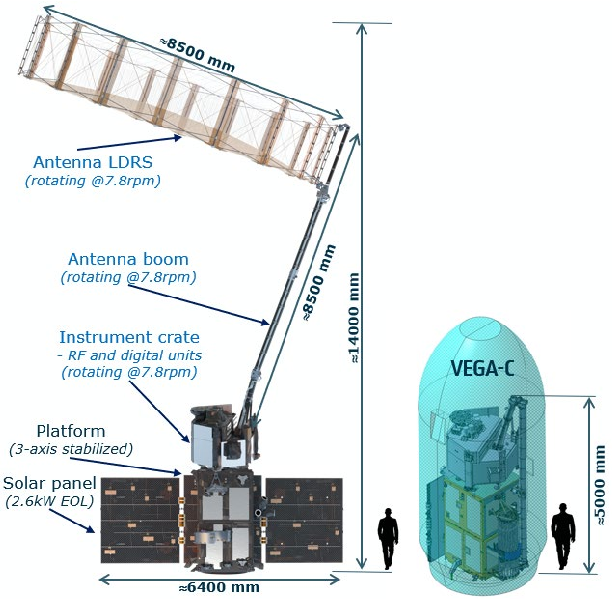
Oktober 2024
HPS Prominently Present at the IAC in Milano
Participating in the International Astronautical Congress, IAC, has developed into a good tradition at HPS over many years. This year, the company will be represented by Ernst K. Pfeiffer, CEO, together with ADEO project manager Mrs. Dorittya Milankowitch from HPS Munich and Horatiu Gheorghe as IAC-contact point for HPS Bucharest with products like secondary structures, thermal hardware and purging equipment. The HPS-team will keep up full presence during all five days of this international event.
Special highlights will be the company presentations; they are going to take place on Friday, 18th, from 10.15 to 10.45 a.m., and also as part of the Company Slam at the booth of the German association BDLI on Tuesday from 13.15 to 13.45 p.m..
Focus of both presentations will be on the product family of the ADEO deorbit sailsystem for automatic disposal of satellites after their end of mission, serving the idea of clean space, sustainability and debris avoidance even from the beginning of the satellite´s journey.
Main products besides ADEO to be asked at our booth: reflector antennas, deployable antennas, large deployable reflector subsystems, mesh, thermal hardware, purging equipment. HPS will warmly welcome there all its customers from both worlds: classic and NewSpace. For a dedicated prearranged business meeting please send a message to Contact@hps-gmbh.com.
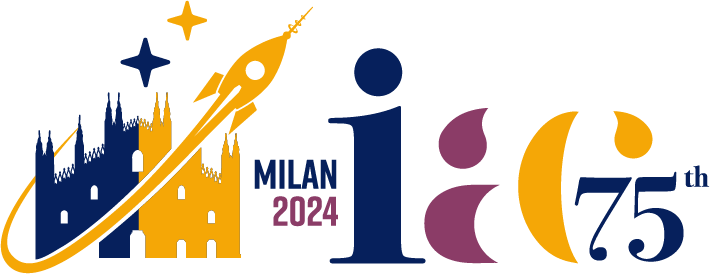
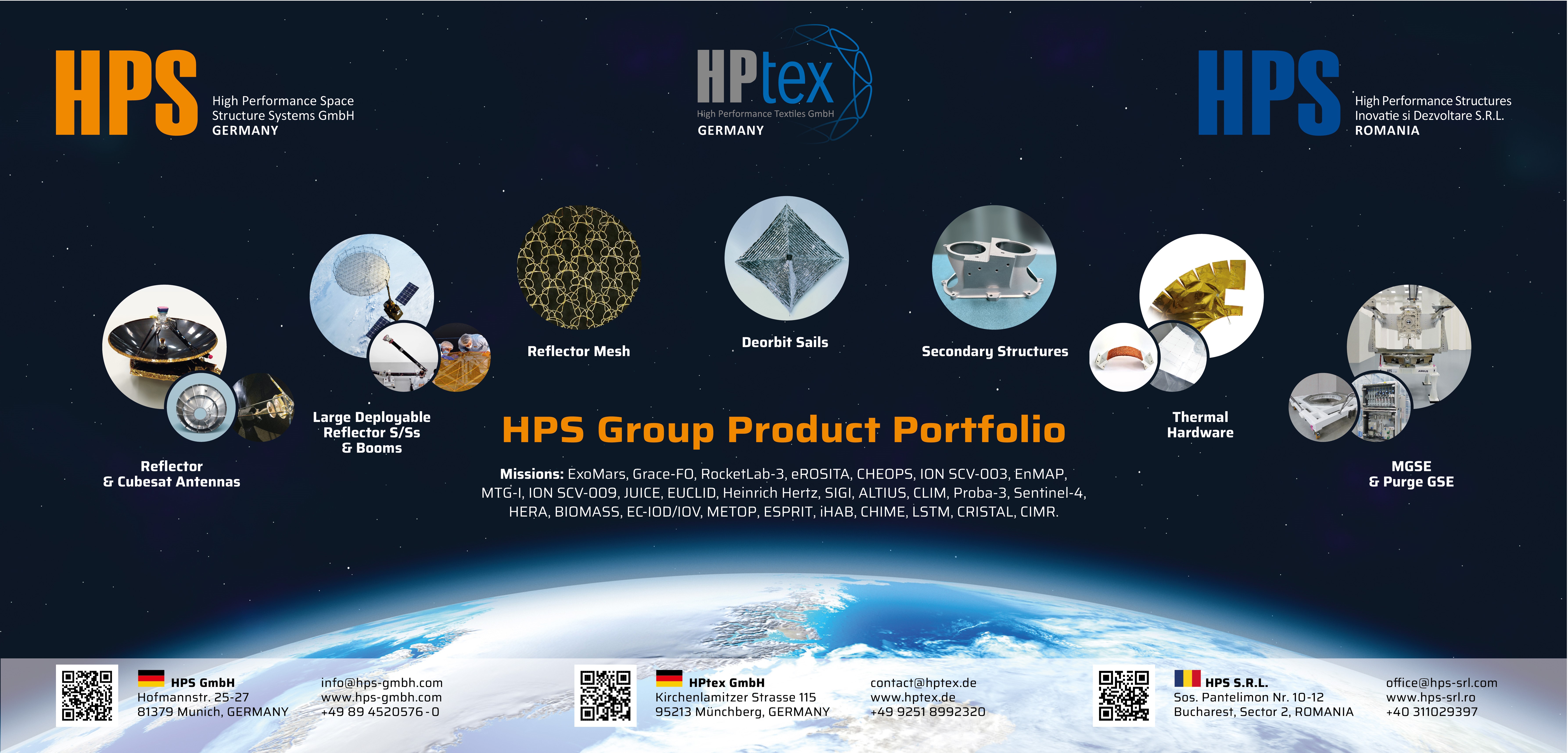
Größtes gemeinsames Innovationsprojekt der europäischen Raumfahrt: CEOs von TAS-I, HPS und LSS setzen Startschuss
Januar 2023
Größtes gemeinsames Innovationsprojekt der europäischen Raumfahrt: CEOs von TAS-I, HPS und LSS setzen Startschuss für Phase C/D der großen entfaltbaren Antenne „LDRS“ im Projekt CIMR
Seit dem spektakulären Gewinn des 110-Millionen € Auftrages für Entwicklung und Bau von LDRS (Large Deployable ReflectorSubsystem) durch das von HPS geführte KMU-Konsortium im Jahre 2020 läuft das Projekt zur Sicherung eines souveränen europäischen Innovationslevels trotz aller Komplexität wie auf Schienen. Das im Laufe der Entwicklung des Projektes stetig gewachsene Vertrauen des Endkunden ESA und seines Hauptauftragnehmers TAS-I für die Mission fand nun Ausdruck am 23.01.2023 in der Besiegelung des Aufbruchs in die Phase CD durch Unterschrift des so genannten „Rider“ für Bau und Test eines Qualifizierungsmodells (EQM) in 2023/2024, gefolgt von gleich zwei Flugmodellen (PFM und FM2).
Tragende Technologie-Säulen des Innovationsprojektes sind neben den Innovations-Hauptpartnern LSS (Entwicklung, Bau und Test des entfaltbaren Reflektors), die HPS-Tochter HPtex (Mesh-Produktion für den Reflektor), FHP (CFRP-Streben für den Reflektor), INVENT (CFRP-Rohr für den entfaltbaren Arm) und vH&S (für die Entfaltkontrollelektronik) weitere 10 Unternehmen aus sieben europäischen Ländern unter Konsortialführung von HPS.
Die Umweltbeobachtungsmission im Rahmen des Copernicus-Erdbeobachtungsprogramms der Europäischen Union ist wesentliches Element der europäischen Raumfahrtstrategie als hoch ambitioniertes Projekt im Bereich der Klimabeobachtung und der Auswirkungen des Klimawandels.
Foto (TAS-I): Vertragsbesiegelung – Mitte: Massimo Camparini (CEO des Raumfahrtkonzerns ThalesAleniaSpace Italien) und die Chefs von HPS, Ernst K. Pfeiffer (rechts) und von LSS, Leri Datashvili
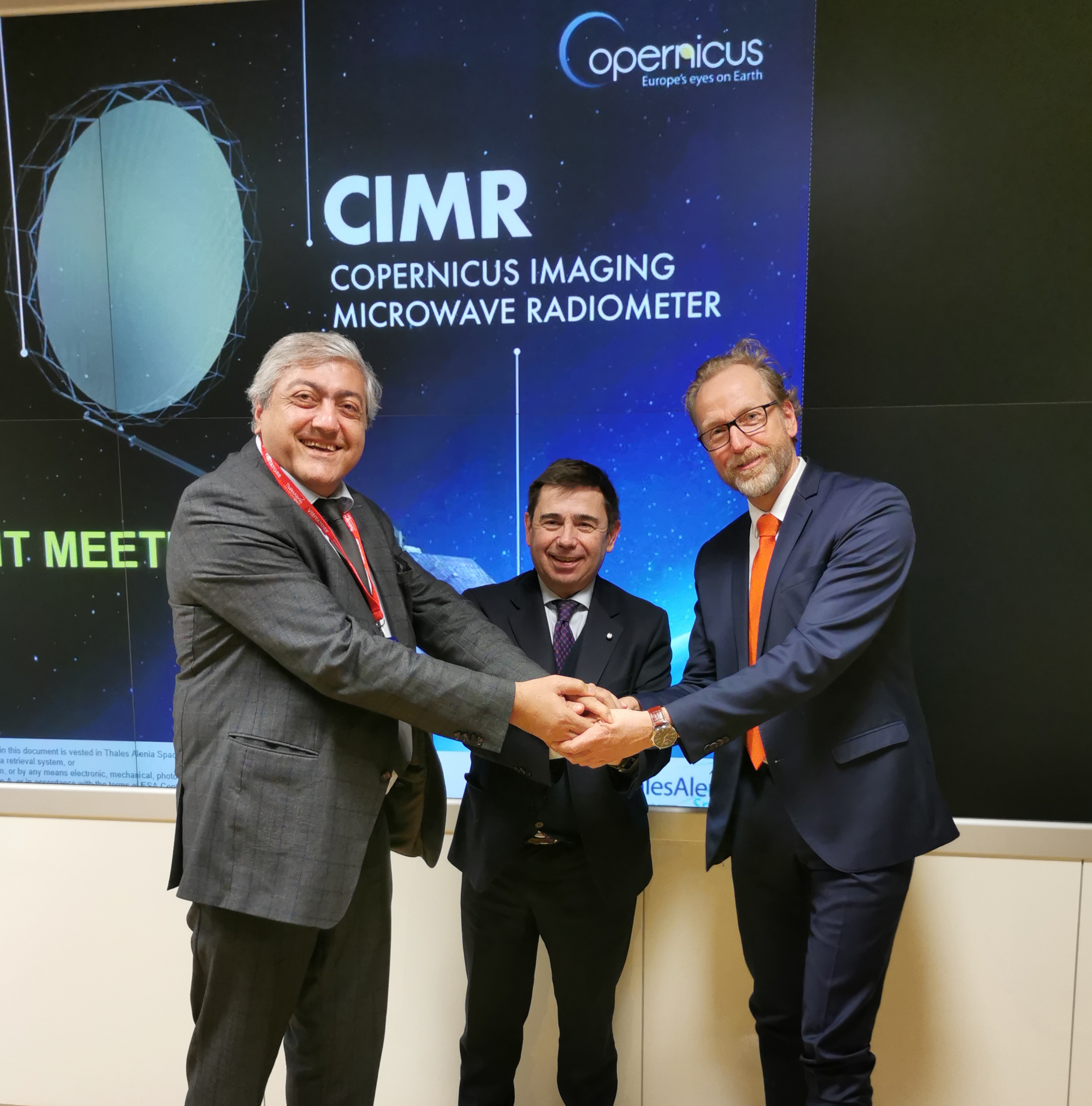
March 2022
LDRS successfully passed the Requirements Review #2
Following, in 2021, the successful passing of both the Copernicus Imaging Microwave Radiometer (CIMR) System Requirements Review and the Large Deployable Reflector Subsystem (LDRS) TRL 5 Declaration milestones, our CIMR-LDRS team has now successfully passed, in March 2022, the LDRS Requirements Review #2. Design requirements for the Ka-band LDRS EQM are now frozen and the EQM detailed design can begin.
Upcoming major milestones in 2022 include both the LDRS ICD Freeze and the LDRS TRL 6 Declaration this Summer, followed by the LDRS PDR planned in Q4, 2022. An important part of the LDRS TRL 6 Declaration milestone is the successful execution of Environmental Test campaign of the 8m diameter LEOB-EM Deployable Reflector by our partner, LSS, being performed at INTA (SP) under the Prime Contract leadership of HPS. Random and Sine Vibration testing is complete and Thermal Vacuum testing is currently in-progress.
CIMR is part of the European Space Agency (ESA) Copernicus program and on CIMR, HPS-Germany is the Prime Contractor for the LDRS under direct contract to the Mission Prime, Thales Alenia Space-Italy. HPS is working closely with its partner, LSS, as the Large Deployable Reflector responsible, and 15 other subcontractors and suppliers from 7 European nations to produce the first-ever all-European LDRS.
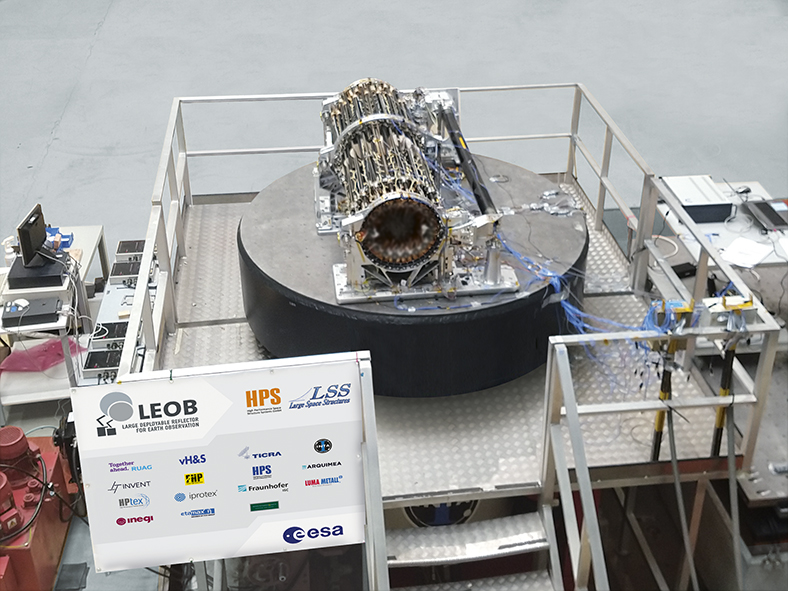
LEA-X5: New Movie on the completion of the European 5m X-band LDRS
Juli 2021
Gladly we announce with a new 20-minutes-movie the completion of the H2020-development „LEA-X5“, the 5m class European Large Deployable Reflector Subsystem (LDRS) operating in X-band.
The film itself is of course showing recent environmental and deployment tests, but it is mainly about PEOPLE, who are space engineers and space enthusiasts, and what they can achieve with combined powers and brains. These people, together with the enablers European Commission and European Space Agency, are making the achievement of „European Non-dependance“ happen.
LEA-X5 is a full LDRS-Subsystem (lead by HPS, Germany) and comprises the
- 5m diameter X-band reflector assembly (lead by LSS, Germany)
- the 5m long deployable arm assembly (lead by HPS, Germany),
- hinges & HDRMs (RUAG, DE),
- deployment electronics (vH&S, DE),
- thermal hardware (HPS/FHP).
Further partners of the H2020-consortium have been: INVENT (DE), FHP (PT), INEGI (PT), TICRA (DK), LUMA (SW), HPTEX (DE), ARQUIMEA(SP), HPS (RO), ETAMAX (DE), WSS (DE), ONERA (FR), TAS (FR), OHB (DE), Airbus (DE).
Most of the consortium members are introduced in the movie, inluding many interviews.
Take your time and enjoy the spirit of doing big things: LEA-X5 – European 5m X-band LDRS Completed (Final Report 06/2021) – YouTube
Best regards,
Your WeLEA-Consortium
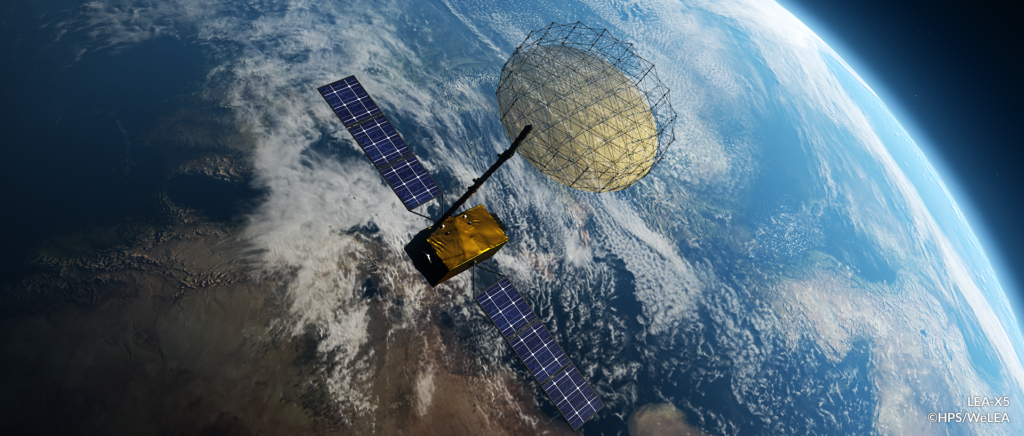
Januar 2015
Under the auspices of the German ministry of economy and energy and DLR Germany had decided to entrust a team of SME-companies under the lead of RWTH-Aachen and several other highly renowned institutes with studies about mission profiles and potentials based on large deployable antenna (LDA)-applications, named SMERALDA (SME´s Radar and Large Deployable Antenna). HPS, the mid-sized antenna specialist and leading space-subsystem manufacturer, was responsible for the central LDA-part of the project that provided a respective concept for a small-scale-mission using a 5-meter LDA.
The study was successfully finished mid December 2014 and presented to a large audience at the German Space Agency in Bonn including to one of DLR’s directors Mr. Christoph Hohage.
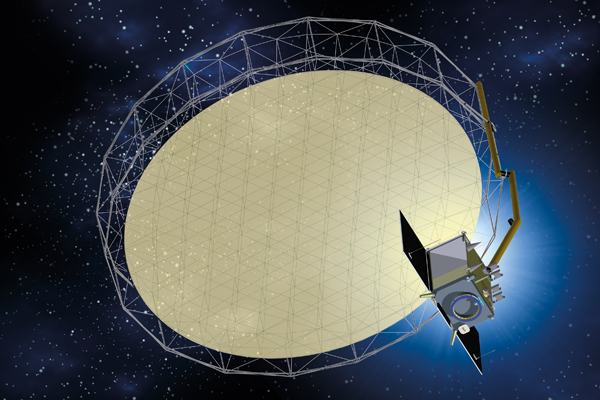
HPS announcing crucial milestone set for Europe´s own large deployable reflector subsystem (LDRS)
April 2019
Large deployable antenna reflectors are among the critical space technologies most urgently needed in Europe in order to drastically reduce the continent´s dependence on goodwill, knowhow, and supplies from the United States. Therefore, back in fall 2017 the EC decided to co-fund in the fame of its Horizon 2020-programm the 7 million € development-project LEA (Large European Antenna) of a consortium with 15 partners out of six European (D, SP, PT, SE, DK, FR) countries under the implementation leadership of HPS, Germany, among them also LSS GmbH (Germany) and RUAG Space Germany. A special cooperation between HPS and Northern Bavarian entities has already led to the development of the central component, the „European Space Mesh“; it will in future be produced in Bavaria. Now the project has taken its crucial milestone when it passed the Critical Design Review (CDR) in April 11-12, 2019, and is heading towards the final stage of its test campaign from February through August 2020. In exchange for the opportunity to gain flight heritage HPS offers the first product, LEA, for free to any customer worldwide.
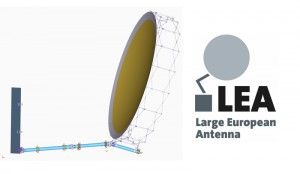
Major specs of LEA are: deployable reflector aperture at 5.1 meters with a 5.6 meter long deployable arm; a mass of just 100 kilo including reflector, arm, hold-down-and-release-mechanism, harness, thermal hardware, operating frequency: X-band. The stowed volume is as small as 2.6 x 1.2 x 0.6 meters.
This development is not only important in general, but serves also as a baseline for two potentially next Copernicus missions at the horizon with 8 and 12 meter reflector subsystems. The whole development program of LEA is based on precursors undertaken within the framework of ESA technology programs.
For more information on LEA please klick: www.welea.eu.
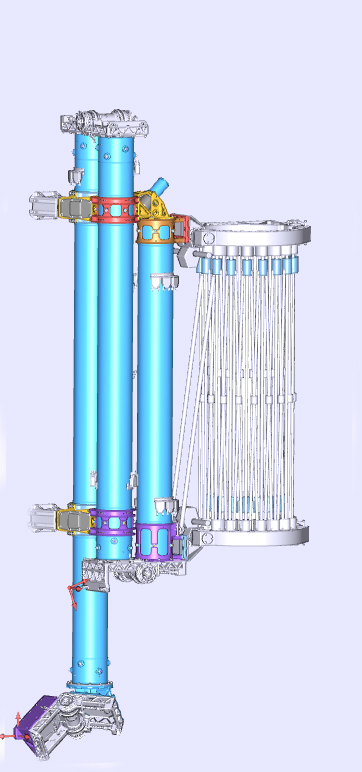
April 2019
MdB Dr. h.c. Thomas Sattelberger gratuliert HPS zur frisch gewonnenen Führungsrolle in europäischer Innovations-Offensive
Am 18. April 2019 besuchte Thomas Sattelberger (FDP), Bundestagsabgeordneter des Wahlkreises München Süd, den Raumfahrt-Mittelständler HPS. Als ausgewiesener Innovationsexperte interessierte er sich dabei vor allem für die vom deutschen Raumfahrt-Mittelstand ausgehenden Impulse für neue Technologien, mit denen Europa im Rahmen von EU und ESA seine Unabhängigkeit von Zulieferungen und Wohlwollen seitens der Konkurrenz anderer Kontinente gerade in kritischen Bereichen erkämpft.

Gerade auf diesem Gebiet hat HPS jüngst zwei bahnbrechende Erfolge zu verzeichnen: Die Entwicklung des HPS-Bremssegels ADEO zur schnellen Entsorgung ausgedienter Satelliten hat vor wenigen Monaten seinen Feuertest im All mit Bravour bestanden, und vor wenigen Tagen gewann ein von HPS geführtes Konsortium von 17 meist mittelständischen Raumfahrtunternehmen aus sechs Ländern gegen große Konkurrenz den Entwicklungsauftrag für die künftige große entfaltbare Antennentechnologie Europas mit Einsatzgebieten von Erdbeobachtung über Big Data und das Internet of Things bis hin zu militärischen und Telekommunikationsanwendungen.
HPS-CEO Dr. Ernst K. Pfeiffer nahm die Gelegenheit wahr, die Bedeutung des Ausbaus von Technologie-Programmen für die Raumfahrt-Zulieferindustrie auf nationaler und europäischer Ebene gerade auch für die Ermöglichung der Teilnahme an den steigenden internationalen Märkten und damit verbunden die Jobmaschine der Raumfahrt-KMU hervorzuheben. Die ESA Ministerratskonferenz 2019 liefert dafür die beste Gelegenheit, um sowohl die ESA-Technologieförderung über die Programme ARTES und GSTP sowie auch die deutsche Beteiligung am EU-Programm Kopernikus nachhaltig zu stärken. MdB Thomas Sattelberger bestätigte die enorme Bedeutung der Raumfahrt als Anwendung für die Menschen auf der Erde wie auch als Technologietreiber für andere Wirtschaftsbereiche. Seine Expertise hatte er selbst in langjähriger Arbeit im Bereich der bayerischen Luft- und Raumfahrttechnik gewonnen, bevor er nach seiner Position als Vorstandsmitglied bei der Deutschen Lufthansa und seiner letzten beruflichen Station als Vorstandsmitglied der Deutschen Telekom für die Freien Demokraten in den Bundestag einzog.
KMU-Konsortium weist Weg zu europäischer Unabhängigkeit bei kritischer Raumfahrttechnologie
Mai 2019
Mittelstand um HPS gewinnt auch entscheidende zweite Ausschreibung
Das europäische Konsortium aus 17 vornehmlich mittelständischen Partnern aus sechs Ländern hat unter Führung von HPS GmbH, München, nun im April 2019 auch den ESA-Vertrag zur Entwicklung von LEOB, des „großen entfaltbaren Antennenreflektors für Erdbeobachtung“ gewonnen, ausgeschrieben vom ESA-Direktorat für Erdbeobachtung. Die KMU-Gruppe mit einem deutschen Arbeitsanteil von 80% (darunter auch Münchner Firma LSS als einer der Hauptunterauftragnehmer) setzte sich damit gegen starke Konkurrenz aus Italien, Spanien und England durch und ist hierbei für die nächsten 10 Jahre in Europa an der Spitze.
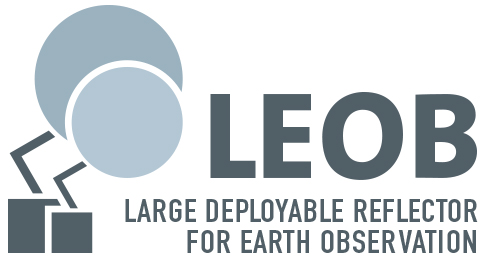
Bereits Ende 2017 hatte sie die EU-Ausschreibung „LEA“ aus dem Horizon 2020-Programm für die Entwicklung eines 5 Meter großen, flugtauglichen Modells gewonnen. Dotiert sind beide Verträge mit je 5 Millionen Euro, zusammen mit 2,5 Millionen Eigenbetrag stehen dem KMU-Konsortium nun 12,5 Millionen für dreieinhalb Jahre zur Verfügung. Damit kann 2021 ein Ingenieurmodell als Grundlage für Flughardware präsentiert werden, welches zwei potentielle Kopernikus-Missionen bedienen kann: CIMR (Beobachtung der Entwicklung der Eismeere, der Wassertemperaturen und des damit zusammenhängenden Wetters) mit einem 7-8m Reflektor für L- bis Ka-band, welcher zudem mit zehn Umdrehungen auf der Spitze des Satelliten rotiert, und ROSE-L (Beobachtung der Vegetation und Bodenfeuchtigkeit sowie Verbesserung der Nahrungssicherheit, „Precision Farming“ und Überwachung des Schiffverkehrs „Maritime Surveillance“) mit 12 Metern Durchmesser für L-band.
Grundlage des für Deutschland erneuten und nunmehr für die Zukunft dieser kritischen Technologie in Europa entscheidenden Erfolgs sind Entwicklungsschritte im Zusammenhang mit ESA-Technologieprogrammen.
„LEOB“ wird enorme technologische und strategische Auswirkungen haben:
- Nach LEA ist es der entscheidende zweite Schritt zur Herstellung europäischer Unabhängigkeit bei einer höchst kritischen Technologie von Zulieferungen und vom Wohlwollen amerikanischer Unternehmen und vermeidet zudem den Abfluss deutscher und europäischer Steuergelder zum Weltmarktführer in die USA.
- Anwendungen von Erdbeobachtung über Telekommunikation (einschließlich „Big Data“, „Internet of Things“) bis hin zu sicherheitspolitisch relevanten Infrastrukturen im All werden nachhaltig und zu konkurrenzfähigen Konditionen in Europa realisierbar.
- Es ist der Beleg dass mit entsprechendem politischen Rückhalt sich das große Potential des deutschen Raumfahrt-Mittelstandes entfalten kann, sowohl als Initiator für Innovationen als auch als „Jobmaschine“
- Es ermöglicht, Raumfahrttechnologie „Made in Germany“ auch Kunden aus nicht-europäischen Ländern und Regionen anzubieten.
- Die diesjährigen deutschen Zeichnungen bei Kopernikus und den Technologieprogrammen der ESA, insbesondere ARTES und GSTP, werden zeigen, wie viel dies der Bundesregierung wert ist.
Oktober 2019
A European Declaration of Non-dependence in Space
Dear Friends and Fans of Europe in Space,
in the name of all members of our pan-European WeLEA-consortium we proudly present a video, documenting the successful road of the development of one of the most needed critical technologies in space: the Deployable Large European Antenna (LEA).
Invented, designed, tested and manufactured by more than 15 well known space companies from 7 European countries with a total staff of more than 500 dedicated specialists, representing a truly unique team of SMEs and Midcaps, the LEA-product is now taking shape as nothing less than “A European Declaration of Non-dependence in Space”.
Thanks to the farsighted vision of both powerful institutions responsible for our continent´s future in space, the European Space Agency ESA and the European Commission EC, LEA will become an invaluable technological asset to blaze our own trail towards knowledge and understanding as indispensable prerequisites to making this world a sustainable, better place – for life in diversity, for all citizens on the globe, and for one Europe across all its internal borders.
Within the WeLEA consortium HPS Germany, as prime contractor, is responsible for the project- and technical management of the whole LEA-subsystem, the deployable arm assembly and the reflective metal mesh.


